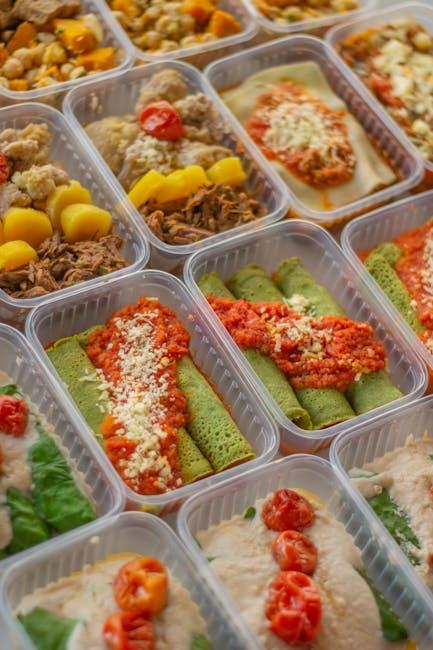Embarking on a low-carb diet can be a transformative journey, unlocking new levels of energy, mental clarity, and overall well-being. However, one of the most common challenges faced by individuals on this path is managing hunger while maintaining nutritional balance. Fear not, as there are effective strategies to help you stay full and satisfied without compromising your carb count. In this article, we will delve into the best ways to keep hunger at bay while adhering to a low-carb lifestyle, ensuring you remain on track and motivated. With the right approach, you can achieve your dietary goals without feeling deprived or constantly reaching for snacks. Let’s explore how you can harness the power of nutrition to stay satiated and energized throughout your day.
Master Protein-Packed Meals for Sustained Fullness
Elevate your low-carb lifestyle by incorporating protein-rich meals that not only keep you satisfied but also fuel your body with essential nutrients. Embrace the power of lean meats like chicken and turkey, which are excellent sources of protein and can be prepared in a variety of delicious ways. Consider grilling, baking, or even slow-cooking them to perfection. For seafood lovers, options like salmon and tuna offer a double benefit of high protein and healthy fats.
Don’t forget about the versatility of eggs, a staple in any low-carb diet. Whether scrambled, poached, or made into a hearty omelet, eggs provide a quick and easy protein boost. Explore plant-based proteins too, such as tofu and tempeh, which can be marinated and sautéed for a satisfying meal. Pair these with nutrient-dense, low-carb vegetables like spinach, broccoli, and kale for a well-rounded dish. Here are some ideas to get you started:
- Grilled Chicken Salad: Toss together grilled chicken, mixed greens, avocado, and a sprinkle of feta cheese.
- Egg and Spinach Scramble: Cook eggs with fresh spinach and a dash of garlic powder for a quick breakfast.
- Baked Salmon with Asparagus: Season salmon fillets with lemon and dill, then bake alongside asparagus spears.

Incorporate High-Fiber Vegetables to Boost Satiety
When navigating a low carb diet, one effective strategy to ensure lasting fullness is to integrate high-fiber vegetables into your meals. These veggies not only add essential nutrients but also increase the volume of your meals without a hefty carb load. By incorporating these fiber-rich options, you can curb hunger pangs and maintain energy levels throughout the day.
- Leafy Greens: Spinach, kale, and Swiss chard are excellent choices that provide fiber and can be easily added to salads, smoothies, or sautéed dishes.
- Cruciferous Vegetables: Broccoli, cauliflower, and Brussels sprouts offer a satisfying crunch and can be roasted, steamed, or eaten raw with dips.
- Bell Peppers: These colorful veggies are not only high in fiber but also packed with vitamin C, making them a versatile addition to stir-fries and salads.
- Asparagus: This spring vegetable is a fantastic source of fiber and can be grilled, steamed, or incorporated into omelets and casseroles.
Integrating these high-fiber vegetables into your meals will help you feel satiated longer, supporting your low carb lifestyle without compromising on flavor or nutrition.

Embrace Healthy Fats for Long-Lasting Energy
When you’re on a low-carb diet, incorporating healthy fats is crucial for maintaining energy levels and feeling satiated. Avocados, nuts, and seeds are excellent sources of monounsaturated and polyunsaturated fats that not only keep you full but also support heart health. Consider adding a handful of almonds or walnuts to your salads, or enjoy a creamy avocado spread on your low-carb toast.
In addition to plant-based options, fatty fish like salmon, mackerel, and sardines are rich in omega-3 fatty acids, which are known for their anti-inflammatory properties. Cooking with oils such as olive oil or coconut oil can also enhance your meals with beneficial fats. These choices not only provide long-lasting energy but also help your body absorb fat-soluble vitamins more effectively.
- Incorporate a variety of nuts and seeds into your diet.
- Opt for fatty fish to boost omega-3 intake.
- Use oils like olive and coconut for cooking and dressings.

Utilize Mindful Eating Techniques to Enhance Satisfaction
Embracing the art of eating mindfully can transform your low carb journey by amplifying both satisfaction and satiety. Mindful eating encourages you to savor each bite, allowing your brain to register fullness more accurately. Start by creating a calm eating environment, free from distractions such as phones or TV. This setting allows you to focus on the flavors, textures, and aromas of your food, enriching your dining experience.
- Chew thoroughly: Take the time to chew each bite slowly, which aids in digestion and allows you to enjoy the complex flavors of your meal.
- Listen to your body: Pay attention to your hunger cues. Stop eating when you feel comfortably full, not when your plate is empty.
- Engage your senses: Notice the colors, smells, and textures of your food, which can enhance your overall satisfaction and make even simple meals feel more indulgent.
By integrating these techniques, you not only enjoy your meals more but also help prevent overeating, making it easier to maintain your low carb lifestyle with ease and pleasure.
